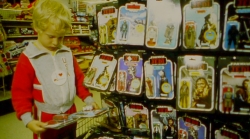Cinema | October 22nd, 2014

By fans, for fans, “Plastic Galaxy: The Story of Star Wars Toys” covers the profitable marriage of George Lucas’ phenomenal movie and Kenner Products, the Cincinnati-based company that acquired the license to produce action figures, vehicles, and other playthings based on Luke Skywalker, Princess Leia, Darth Vader and the many inhabitants of the “Star Wars” universe. Director Brian Stillman alternates between the super collectors who have devoted the majority of their spare time and money amassing private hordes and the onetime Kenner staff members responsible for the concepts and designs that would result in the sale of an estimated quarter of a billion action figures during the line’s 1978-1985 run.
Many of the best-known legends of the classic Kenner “Star Wars” toys, including double telescoping light sabers, the redesign of Snaggletooth, and the rocket-firing Boba Fett, receive their expected analysis. Several players from the Kenner team, including design manager Ed Schifman, talk about the impact of visionary Kenner president Bernie Loomis, the man who shepherded the company’s “Star Wars” license and coined the term “toyetic” as a descriptor of the importance of a product’s imaginative play value. Although Schifman claims credit in the movie, Loomis is often associated with the idea of the “Early Bird Certificate Package,” the empty box promise that sold more than 500,000 pre-orders for “Star Wars” toys that were not ready in time for the holiday season of 1977.
Despite the level of detail provided in the movie’s numerous anecdotes, Stillman leaves out several stories that are considered de rigueur within the lore. For example, discussions of figure variations such as the vinyl cape versus cloth cape Jawa and the “pinhead” versus big head Han Solo are omitted. Additionally, no information is given regarding the process of naming figures like Walrus Man and Hammerhead. “Plastic Galaxy” does, however, touch on the extent to which Lucas was involved with and protective of his brand, tracing the early days that saw Kenner employees taking snapshots during theatrical screenings of “Star Wars,” before Lucasfilm reference material and documentation was routinely provided to designers and sculptors.
Another of the great mysteries of Kenner’s “Star Wars” history that remains largely unexplored in the movie is the process by which characters were chosen to be immortalized. “Plastic Galaxy” includes some nice commentary on the appeal of offering figures based on minor personalities, background creatures, and fringe aliens and droids, but nothing is said concerning the absence of more prominent players like Grand Moff Tarkin, Uncle Owen and Aunt Beru. Sure to set the hearts of the most devoted enthusiasts aflutter, those three, as well as the cantina musicians, General Dodonna, and assorted X-wing pilots, do appear on an early Jim Swearingen memo of proposed figures and ships.
Modestly budgeted (the movie was funded partially through a Kickstarter campaign), “Plastic Galaxy” makes hay under fair use exceptions to copyrighted material, incorporating a number of commercials and clips featuring scenes from “Star Wars” along with John Williams’ instantly recognizable score. Nearly all of the interviews are static, talking head compositions, and the documentary’s chief visual interest resides in both the archival material from Kenner and the many vintage photographs of kids and their toys. Crude animations and chapter-break title cards with banal statements like “The End of the Line?” and “Star Wars Is Forever” aren’t particularly inspired.
Unsurprisingly, “Plastic Galaxy” is male-centric. Then, as now, toy companies segregated properties into “boy toys” and “girl toys.” Of more than two-dozen interviews, only one woman, collector Lisa Stevens, is included in the movie, and even though Kenner employed several women who worked on the “Star Wars” account, none appear on camera. The aging fanboys eager to show off their stockpiles can be annoying and amusing in equal measure. Every so often, they manage to sound insightful. The recognition, for example, that Kenner TV ads deliberately suggested scenes that were not part of the movie underscores the importance of using one’s imagination and reminds us why we play with toys in the first place.
“Plastic Galaxy” is available on demand from Vimeo.
December 29th 2025
December 29th 2025
December 16th 2025
December 9th 2025
December 2nd 2025
_(1)_(1)_(1)__293px-wide.jpg)
_(1)_(1)_(1)__293px-wide.jpg)
_(1)__293px-wide.jpg)

__293px-wide.jpg)
_(1)__293px-wide.png)